Abstract
Cell-mediated immunity was assessed in 14 Brazilian patients with acute untreated American visceral leishmaniasis (AVL) and in 11 healthy patients successfully treated 1 to 14 years previously. The diagnosis of AVL was established by demonstration of leishmania in bone marrow aspirates. The responsiveness of peripheral blood mononuclear cells to Leishmania chagasi antigens and phytohemagglutinin was studied in vitro. Soluble preparations of L. chagasi antigens were obtained from frozen-thawed promastigote cultures. L. chagasi antigen-stimulated lymphocytes from untreated AVL patients were unresponsiveness and incorporated a mean of 1.2 +/- 0.5 X 10(-3) cpm after a [3H]thymidine pulse. The cured AVL patients had 19.1 +/- 7.2 cpm, and 15 normal control subjects had 0.8 +/- 0.1 cpm. There were no differences in the response of controls and either untreated or cured AVL patients to phytohemagglutinin stimulation. Three of four untreated AVL patients responded to L. chagasi antigens when studied 2 to 4 weeks after therapy. The impaired response of lymphocytes from untreated AVL patients could not be attributed to either reduced numbers of circulating T cells or the inhibitory effect of monocytes or serum factors.
Full text
PDF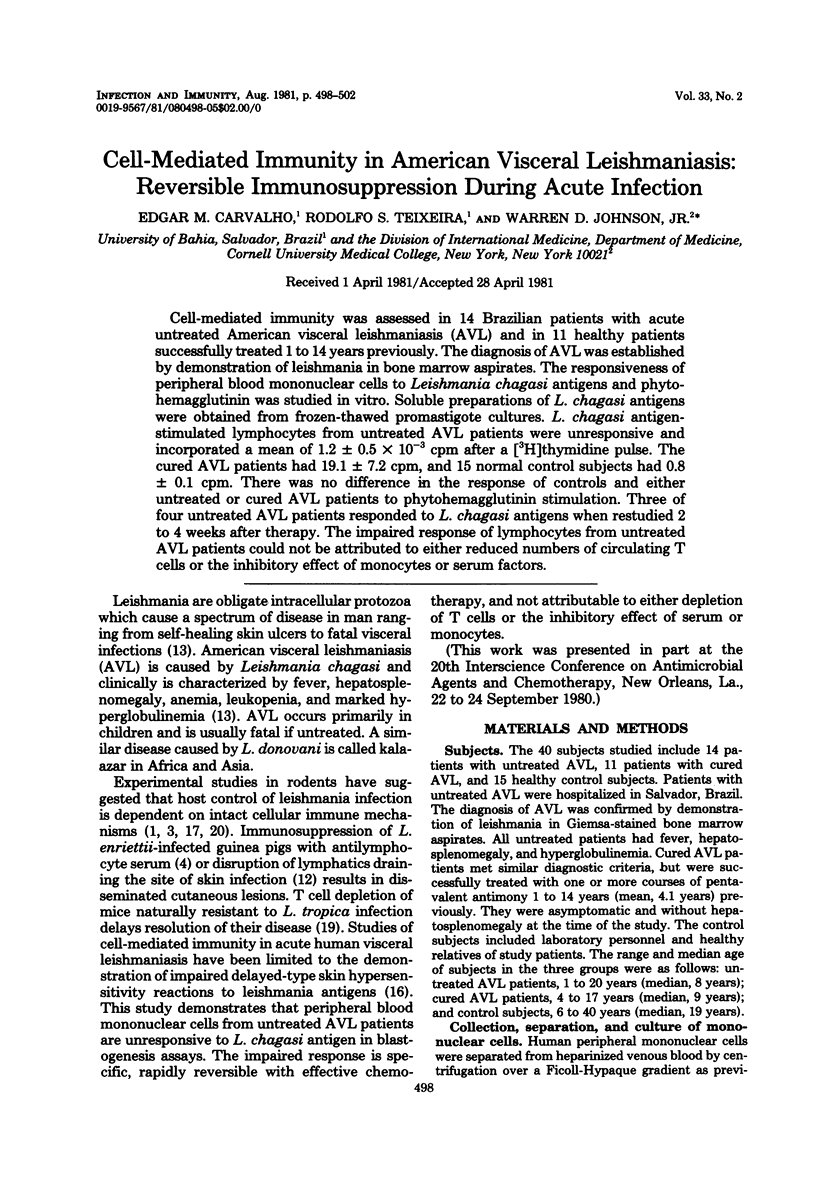
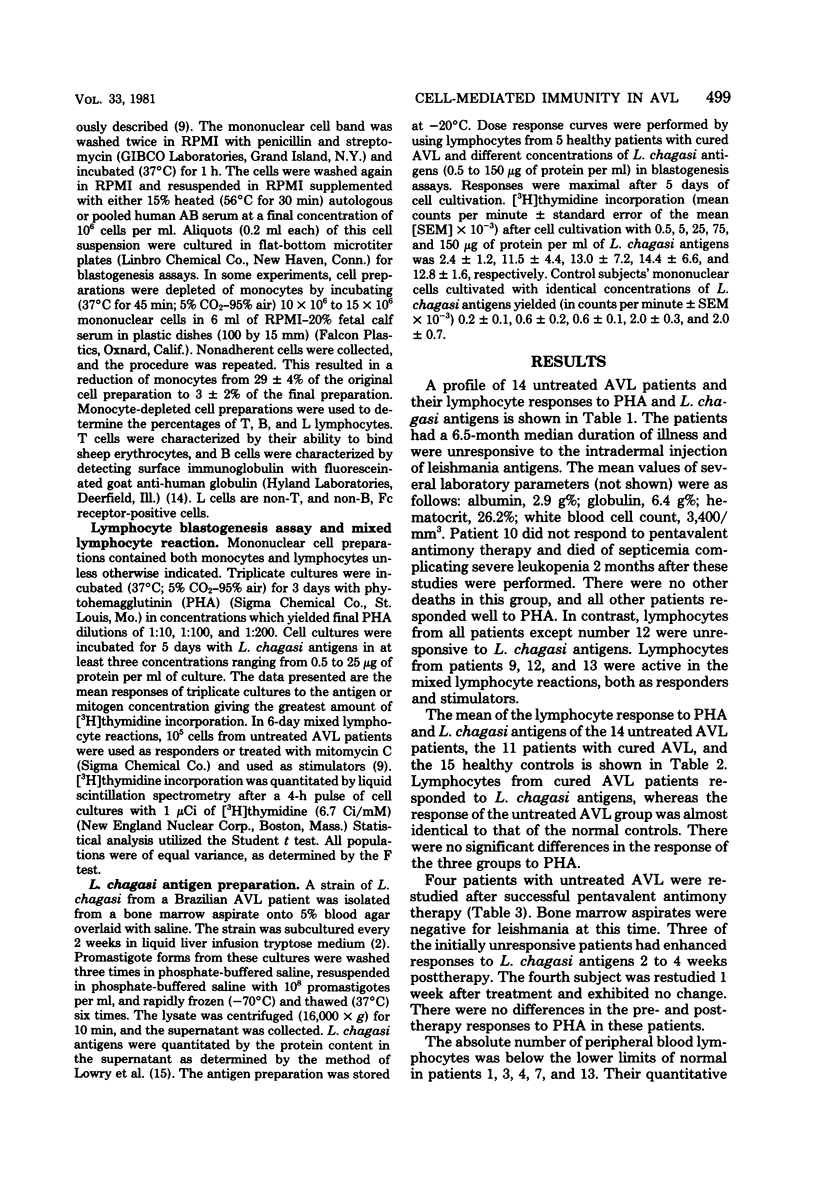
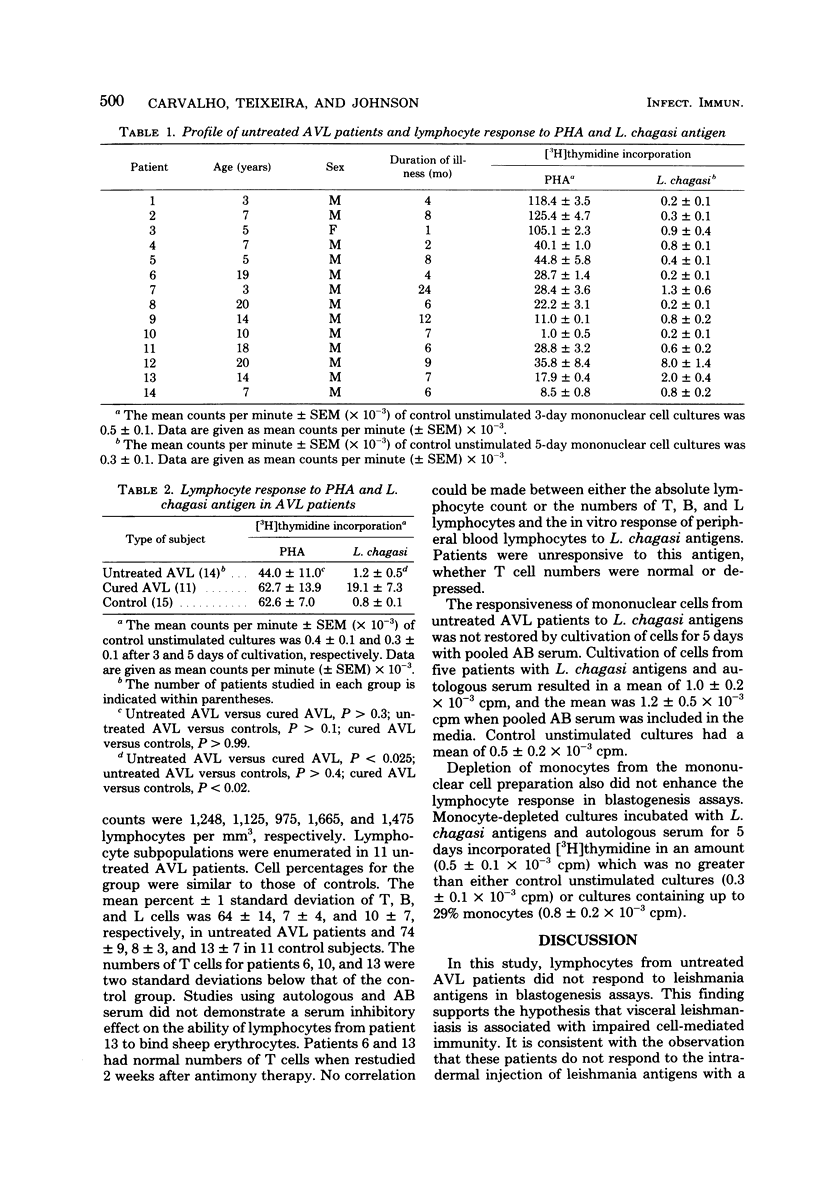
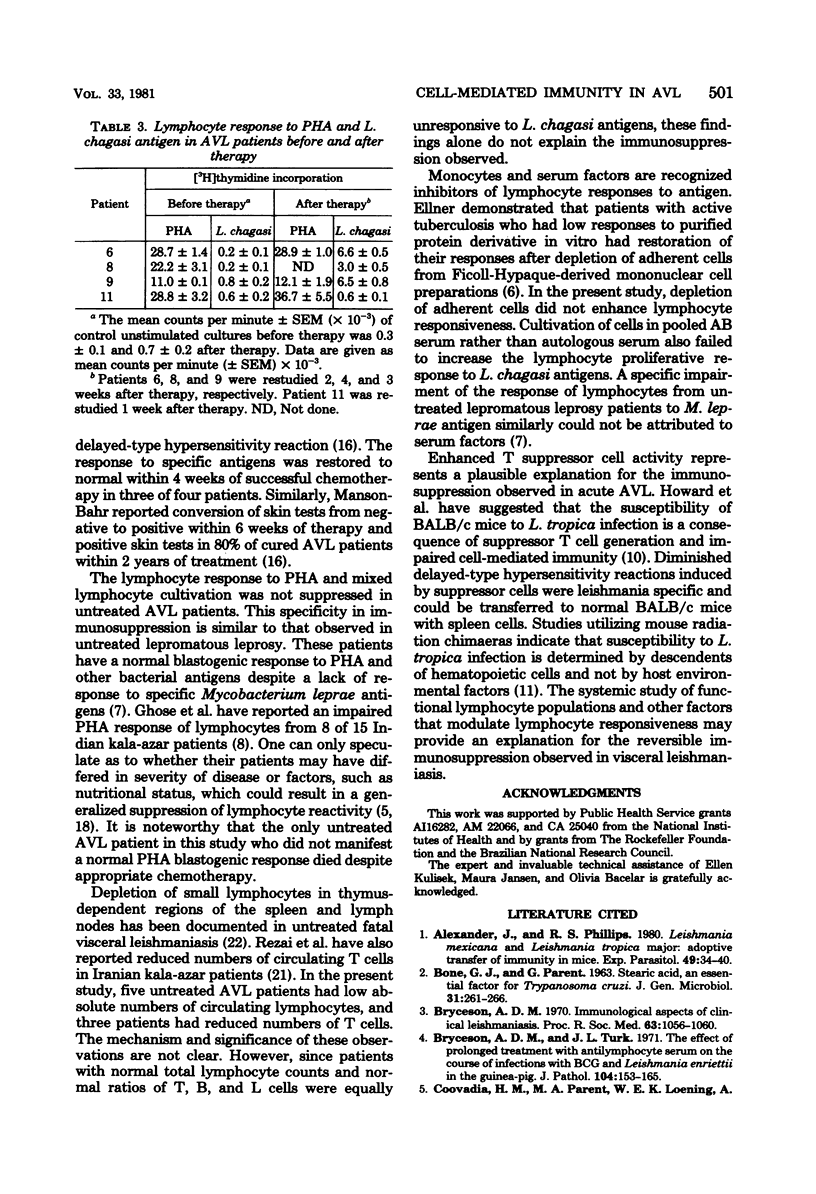
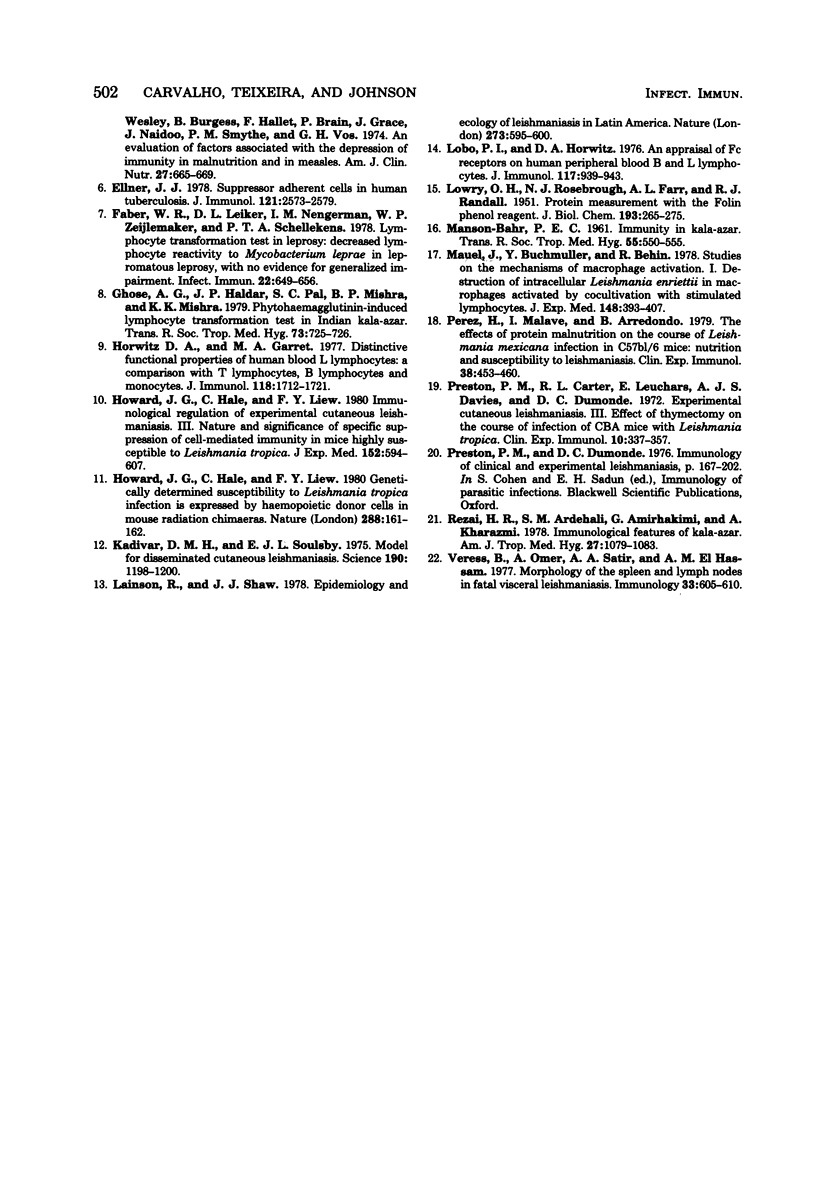
Selected References
These references are in PubMed. This may not be the complete list of references from this article.
- Alexander J., Phillips R. S. Leishmania mexicana and Leishmania tropica major: adoptive transfer of immunity in mice. Exp Parasitol. 1980 Feb;49(1):34–40. doi: 10.1016/0014-4894(80)90053-3. [DOI] [PubMed] [Google Scholar]
- BONE G. J., PARENT G. Stearic acid, an essential growth factor for Trypanosoma cruzi. J Gen Microbiol. 1963 May;31:261–266. doi: 10.1099/00221287-31-2-261. [DOI] [PubMed] [Google Scholar]
- Bryceson A. D. Immunological aspects of clinical leishmaniasis. Proc R Soc Med. 1970 Oct;63(10):1056–1060. [PMC free article] [PubMed] [Google Scholar]
- Bryceson A. D., Turk J. L. The effect of prolonged treatment with antilymphocyte serum on the course of infections with BCG and Leishmania enriettii in the guinea-pig. J Pathol. 1971 Jul;104(3):153–165. doi: 10.1002/path.1711040302. [DOI] [PubMed] [Google Scholar]
- Ellner J. J. Suppressor adherent cells in human tuberculosis. J Immunol. 1978 Dec;121(6):2573–2579. [PubMed] [Google Scholar]
- Faber W. R., Leiker D. L., Nengerman I. M., Zeijlemaker W. P., Schellekens P. T. Lymphocyte transformation test in leprosy: decreased lymphocyte reactivity to Mycobacterium leprae in lepromatous leprosy, with no evidence for a generalized impairment. Infect Immun. 1978 Dec;22(3):649–656. doi: 10.1128/iai.22.3.649-656.1978. [DOI] [PMC free article] [PubMed] [Google Scholar]
- Ghose A. C., Haldar J. P., Pal S. C., Mishra B. P., Mishra K. K. Phytohaemagglutinin-induced lymphocyte transformation test in Indian kala-azar. Trans R Soc Trop Med Hyg. 1979;73(6):725–726. doi: 10.1016/0035-9203(79)90032-4. [DOI] [PubMed] [Google Scholar]
- Horwitz D. A., Garrett M. A. Distinctive functional properties of human blood L lymphocytes: a comparison with T lymphocytes, B lymphocytes, and monocytes. J Immunol. 1977 May;118(5):1712–1721. [PubMed] [Google Scholar]
- Howard J. G., Hale C., Liew F. Y. Genetically determined susceptibility to Leishmania tropica infection is expressed by haematopoietic donor cells in mouse radiation chimaeras. Nature. 1980 Nov 13;288(5787):161–162. doi: 10.1038/288161a0. [DOI] [PubMed] [Google Scholar]
- Howard J. G., Hale C., Liew F. Y. Immunological regulation of experimental cutaneous leishmaniasis. III. Nature and significance of specific suppression of cell-mediated immunity in mice highly susceptible to Leishmania tropica. J Exp Med. 1980 Sep 1;152(3):594–607. doi: 10.1084/jem.152.3.594. [DOI] [PMC free article] [PubMed] [Google Scholar]
- Kadivar D. M., Soulsby E. J. Model for disseminated cutaneous leishmaniasis. Science. 1975 Dec 19;190(4220):1198–1200. doi: 10.1126/science.1198104. [DOI] [PubMed] [Google Scholar]
- LOWRY O. H., ROSEBROUGH N. J., FARR A. L., RANDALL R. J. Protein measurement with the Folin phenol reagent. J Biol Chem. 1951 Nov;193(1):265–275. [PubMed] [Google Scholar]
- Lainson R., Shaw J. J. Epidemiology and ecology of leishmaniasis in Latin-America. Nature. 1978 Jun 22;273(5664):595–600. doi: 10.1038/273595a0. [DOI] [PubMed] [Google Scholar]
- Lobo P. I., Horwitz D. A. An appraisal of Fc receptors on human peripheral blood B and L lymphocytes. J Immunol. 1976 Sep;117(3):939–943. [PubMed] [Google Scholar]
- MANSON-BAHR P. E. Immunity in kala-azar. Trans R Soc Trop Med Hyg. 1961 Nov;55:550–555. doi: 10.1016/0035-9203(61)90078-5. [DOI] [PubMed] [Google Scholar]
- Mauel J., Buchmüller Y., Behin R. Studies on the mechanisms of macrophage activation. I. Destruction of intracellular Leishmania enriettii in macrophages activated by cocultivation with stimulated lymphocytes. J Exp Med. 1978 Aug 1;148(2):393–407. doi: 10.1084/jem.148.2.393. [DOI] [PMC free article] [PubMed] [Google Scholar]
- Preston P. M., Carter R. L., Leuchars E., Davies A. J., Dumonde D. C. Experimental cutaneous leishmaniasis. 3. Effects of thymectomy on the course of infection of CBA mice with Leishmania tropica. Clin Exp Immunol. 1972 Feb;10(2):337–357. [PMC free article] [PubMed] [Google Scholar]
- Pérez H., Malavé I., Arredondo B. The effects of protein malnutrition on the course of Leishmania mexicana infection in C57Bl/6 mice: nutrition and susceptibility to leishmaniasis. Clin Exp Immunol. 1979 Dec;38(3):453–460. [PMC free article] [PubMed] [Google Scholar]
- Rezai H. R., Ardehali S. M., Amirhakimi G., Kharazmi A. Immunological features of kala-azar. Am J Trop Med Hyg. 1978 Nov;27(6):1079–1083. doi: 10.4269/ajtmh.1978.27.1079. [DOI] [PubMed] [Google Scholar]
- Veress B., Omer A., Satir A. A., El Hassan A. M. Morphology of the spleen and lymph nodes in fatal visceral leishmaniasis. Immunology. 1977 Nov;33(5):605–610. [PMC free article] [PubMed] [Google Scholar]


